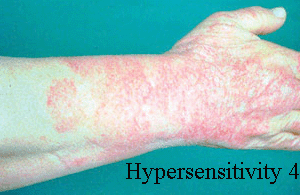- What is Hypersensitivity Reaction Type IV
- Statistics on Hypersensitivity Reaction Type IV
- Risk Factors for Hypersensitivity Reaction Type IV
- Progression of Hypersensitivity Reaction Type IV
- Symptoms of Hypersensitivity Reaction Type IV
- Clinical Examination of Hypersensitivity Reaction Type IV
- How is Hypersensitivity Reaction Type IV Diagnosed?
- Prognosis of Hypersensitivity Reaction Type IV
- How is Hypersensitivity Reaction Type IV Treated?
- Hypersensitivity Reaction Type IV References
What is Hypersensitivity Reaction Type IV
Hypersensitivity means that the body responds to a particular substance (called allergens) in an exaggerated fashion, where it does not happen in normal circumstances. There are 4 types of hypersensitivity reaction, type I, II, III and IV. They are different in terms of the disease manifestation and pathological processes. However, only type IV hypersensitivity reaction will be discussed here.
Type IV hypersensitivity reaction is also called delayed type hypersensitivity reaction because it takes 2 to 3 days for the reaction to develop after exposure to the particular substance.
Type IV hypersensitivity reaction can occur in many parts of the body. Generally, they include:
- Skin: Atopic dermatitis
- Lungs: Tuberculosis , hypersensitivity pneumonitis, Granulomatosis with polyangiitis (formerly known as Wegener’s granulomatosis)
- Pancreas: Type I diabetes mellitus, or known previously as insulin-dependent diabetes mellitus.
- Thyroid: inflammation of the thyroid
- Other: transplant rejection, leprosy
The image below is that of a reaction to the allergen latex:
Statistics on Hypersensitivity Reaction Type IV
Type IV hypersensitivity diseases are common, but less common than type 1 hypersensitivity reaction diseases.
Risk Factors for Hypersensitivity Reaction Type IV
Depending on the manifestations of different type IV hypersensitivity diseases, there are different risk factors as well.
Some diseases are more common in women such as autoimmune diseases. Some are more common in men such as allergic contact dermatitis. The exact mechanism of such discrepancies is unknown.
Likewise, ethnic and geographical differences have roles to play in different diseases.
Progression of Hypersensitivity Reaction Type IV
Type IV hypersensitivity is characterized by cell-mediated response rather than antibodies as in other types of hypersensitivity reactions. Specifically, the T lymphocytes are involved in the development of the sensitivity, hence called cell-mediated hypersensitivity. T lymphocytes are white blood cells in the body.
After exposure to antigens, through a series of biochemical events, the T-cells will be activated. By releasing some chemicals, the T cells activate other white blood cells to mount an immune response.
This entire cascade of reactions take 2-3 days to develop and is different from other types of hypersensitivity reactions.
How is Hypersensitivity Reaction Type IV Diagnosed?
Depending on the different type of diseases, some general investigations may be necessary. Basic routine investigations may include looking at the blood function, liver function, thyroid function and kidney function.
Prognosis of Hypersensitivity Reaction Type IV
Type IV hypersensitivity diseases are usually long-standing and require on-going treatment if there is flaring up of the diseases. However it does not cause life-threatening conditions such as anaphylaxis or angioedema (in type I hypersensitivity diseases).
How is Hypersensitivity Reaction Type IV Treated?
There is no cure for these diseases, the treatment aims at symptom control only. Although type IV hypersensitivity diseases can cause significant inconvenience in terms of their signs and symptoms, with good treatment plan the most of the diseases can be well-controlled.
Depending on the severity of the allergic reaction, different treatment approaches are applied. Treatment options, either given alone or in combination, include the following:
- Allergen avoidance: prevention and avoidance of possible triggers are the mainstay of the treatment. However this is impractical in some diseases such as allergic contact dermatitis because some of the substance cannot be identified and remained unknown for a long period of time. However if known this is a useful and effective method for diseases with known external allergen. This is not applicable for T-cell mediated autoimmune diseases such as type 1 diabetes mellitus.
- Steroids: these drugs are used for late phase of allergic reaction, and they include prednisolone, dexamethasone, etc. Depending on the diseases, steroid could become a long-term medication. In such cases, long term use will need medical supervision for monitoring of potential side effects.
- Other drugs that alter the body’s immune system include interferon, cyclophosphamide, cyclosporine, etc. These drugs are used under specialist supervision.
Hypersensitivity Reaction Type IV References
- Braunwald E et al. Harrison’s principles of internal medicine. 15th ed. New York; McGraw-Hill; 2001.
- Cohen DE, Brancaccio RR, Soter NA: Diagnostic tests for type IV or delayed hypersensitivity reactions. Clin Allergy Immunol 2000; 15: 287-305.
- Middleton E Jr, Reed CE, Ellis EF, et al, eds: Allergy: Principles and Practice. 5th ed. St. Louis, Mo: Mosby-Year Book; 1998.
- The Merck Manual: Disorders with Type I Hypersensitivity Reactions [online]. 2005. [Cited 2005 October 9th]. Available from: http://www.merck.com/mrkshared/mmanual/section12/chapter148/148b.jsp
- Up to Date: Clinical features of rheumatoid arthritis [online]. 2005. [Cited 2005 October 9th]. Available from: http://www.utdol.com/application/topic.asp?file=rheumart/3022&type=A&selectedTitle=1~209
- Wilkinson JD, Rycroft RJG. Contact dermatitis. In: Champion RH, Burton JL, Ebling FJG, editors. Rook/Wilkinson/Ebling textbook of dermatology. 5th ed. Oxford: Blackwell Scientific Publications, 1992:611-715.
All content and media on the HealthEngine Blog is created and published online for informational purposes only. It is not intended to be a substitute for professional medical advice and should not be relied on as health or personal advice. Always seek the guidance of your doctor or other qualified health professional with any questions you may have regarding your health or a medical condition. Never disregard the advice of a medical professional, or delay in seeking it because of something you have read on this Website. If you think you may have a medical emergency, call your doctor, go to the nearest hospital emergency department, or call the emergency services immediately.








